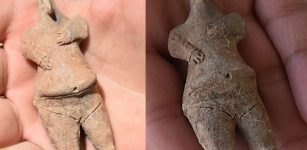Pomegranate-Liked Seeds Found In Ancient Tomb Dated To Han Dynasty
AncientPages.com - More than 100 plant seeds dating back 2,000 years have been unearthed from an ancient tomb in northern China's Inner Mongolia Autonomous Region.
The seeds, which are half-moon-shaped, were discovered gathered in the shape of a circle with a diameter of eight centimeters, on the east side of the female tomb and placed near the buried woman’s head.
The species of the seeds, has not yet been determined but they resemble pomegranate seeds.
The remains of a bronze seal have also been found in the excavated tomb, which is among 18 other single chamber brick tombs, which are scattered among sand dunes of the area and not particularly well preserved.
Archaeologists date the discovery between the middle and late Western Han Dynasty (206 BC - 25 AD) and early Eastern Han Dynasty (25 AD - 220 AD), in Dengkou County, western Inner Mongolia.
Pomegranates are among the fruits, which have a long tradition in China, because there were used both in religious ceremonies and daily life. They were first introduced in China during the Han dynasty was in power in 126 BC.

The pomegranates were first introduced to the country of China during the Han dynasty was in power in 126 BC.
The pomegranates were first introduced to the country of China during the Han dynasty was in power in 126 BC.
The Chinese people used the colorful seeds to create dyes for the hair and even for medicinal purposes. The fruit became a powerful symbol of fertility, eternal life, marriage, prosperity, abundance and reincarnation.
The pomegranate fruit was also mentioned in pomegranate Chinese mythology writings as a symbol used during religious ceremonies by the Buddhists. They regarded the fruit as a good luck charm and sometimes used the small limbs of the tree to sprinkle water during a religious ceremony.
The pomegranate fruit was also regarded as a good luck charm.
AncientPages.com





















